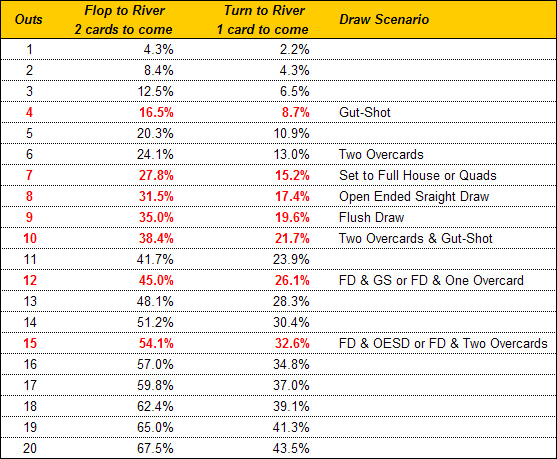The importance of knowing your odds in poker is unquestionable. We often find ourselves placed in a situation where our hand is not yet complete, but there is a good chance that it will improve its standing to be the nuts on the turn or the river. But what are the exact chances of this actually happening to you as a punter? A typical example for a situation like this would have to be when a player is waiting for the flush or the straight. Let’s just say we are dealt :dA :d6 suited and the flop contains :d2 :d7 :hJ. At this moment of time we only have an Ace high, but unforeseen is the real value of our hand: we are holding the nut flush draw, but is it worth the money and the wait?
It is inevitable for a serious player to be able to truly answer this question. If we are in the blind concerning our chances, we will not know with certainty whether it is worth calling the opponent’s bet. Did our opponent bet 10 in a pot of 30? Is it really worth becoming a sheep and following him? How can we really answer this question if we are unclear on our chances?
The answer is simple:
In poker terms, the cards that will complement our hand to make it of greater value are called ’outs’. Now considering outs, how many do we have in the case mentioned above?
In total, we can see the deck contains 13 diamond-suit cards, with two of these residing in our hands and two on the board, this leaves us with 13-(2+2)=9 diamonds. In this case it means that we have 9 outs and any of these will make our hand a nut flush. So, what are the odds of one of these cards turning up on the turn or the river?
The table below provides a clear overview of the connection between the number of outs and your odds:
(If we happen to have 9 outs following the turn, 9 cards out of the remaining 46 will be in our favor to give us the nuts: 9 / 46 = 19.6%)
Upon knowing the number of our outs and the odds in percentages, it is much easier to decide whether or not to call the bet of our opponent. If our chances of improving our hand are greater than the amount of money we need risk (compared to the size of the pot), we need to call, but on the other end of the scale, if the opposite is true, we should not call (not taking the implied odds into consideration!!)
Outs and odds thumb rule
Luckily enough, there is no need to learn the table above by heart, we can simply apply the easily memorisable thumb rule to most situations of gameplay:
If we, for example, happen to have 3 outs, then we have around 3*2=6% odds on each street (so, on the flop these odds are 3*2*2=12%). It can be clearly seen from these figures, that the true percentage is 12.5% on the flop and 6.5% on the river.
But if we have 10 outs, then we have around 10*2=20% odds on each street. (so, on the flop these odds are 10*2*2=40%) It can be clearly seen, that the true percentage is 38.4% on the flop and 21.7% after the turn.
According to all the data above, all we have to do is to multiply the number of our outs by 4 on the flop, and by 2 on the turn. With these easy rule of thumb calculations a player is able to determine his real chances. (The thumb rule gives exact value up to 13 outs, but above this – as it can be seen in the table – there can be greater differences between the higher values, it is important to bear this in mind!)
Good luck, and let the rule of thumb guide you!

